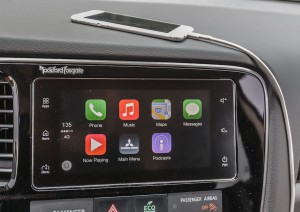The big news out of Apple’s annual developer’s conference is the impending release of the next-generation operating system for devices like the iPhone and iPad. But along with the launch of iOS 9, Apple also plans to upgrade its new CarPlay system.
That’s a major step considering the first cars equipped with CarPlay – including 14 models from Chevrolet – won’t even hit the road until summer. But the revised system will soon be able to do more than play Spotify through your car’s audio system.
Automakers like Chevy will be able to develop proprietary apps of their own that could be used to operate all manner of vehicle functions, such as tracking fuel economy, unlocking a door or finding a vehicle in a crowded stadium parking lot. The update will permit CarPlay to operate on a wider range of screen sizes, as well.
Within the next several years, expect to see Apple CarPlay – and the similar Google Android Auto – show up on a wide variety of vehicles, domestic and foreign. The recently announced Chevy version will give owners access to 10 different audio services, for example, from Spotify to NPR to Major League Baseball – with more apps to follow, the maker hinted.
(Chevy adding CarPlay, Android Auto to 14 models. Click Here for the latest.)
They’ll also be able to have text messages read out by artificial speech and dictate a reply. And motorists will be able to access the smartphone’s built-in navigation, potentially saving $1,000 or more on a factory-installed navi system.
But, at least initially, a user will have to toggle in and out of CarPlay to operate features and apps embedded in the vehicle itself. With many manufacturers migrating to touchscreen controls for essential functions, that could include things like adjusting the climate control or turning seat heaters on and off, as well as tuning the radio or adjusting the volume.
Going forward, it appears, CarPlay would become a seamless part of the vehicle’s touchscreen technology.
But, should a manufacturer choose, they could develop their own, proprietary apps to work within CarPlay. That would seem a logical next step considering makers already are coming up with unique apps. The one for the Chevrolet Volt, for example, can be used to pre-heat the cabin of the plug-in hybrid, check its state of charge and set the time to begin charging the battery in order to take advantage of lower, off-peak electric rates.
(New apps could keep drivers in touch – and out of harm’s way. Click Here to learn more.)
During Monday’s developer’s conference, Apple software chief Craig Federighi also noted a new wireless function for CarPlay. Initially, users will have to use a hardwired connection, with the familiar iPhone Lightning cable, to access the new system. But the plan is to switch to a wireless link, much like most vehicles now can access a smartphone via Bluetooth. Federighi didn’t offer details but a WiFi link may also be possible.
Chevy, as well as Audi, Chrysler and some other makers, are beginning to offer car buyers 4G LTE wireless service that could improve data rates.
(From CarPlay to carmaker – what else does Apple have in store? Click Here for more.)


You can bet that this will be a subscription service. For $100 you can buy a quality portable Nav system that you can use in any car or hand held. No subscription required as the map updates are free for life.
I wouldn’t bet on it being a fee, at least not for basics. Chevy is not charging for CarPlay. Now, when you start getting into OnStar-level services, that could be another story. But recall some competitors already offer some of those for free, as well. Competition can be a wonderful thing.
Paul A. Eisenstein
Publisher, TheDetroitBureau.com
More driver distractions will just result in more accidents. It’s amazing the insanity we are experiencing in the age of technotoys. Driver’s involved in an accident that results from them playing with electronic toys should have their rates increase by $1500/yr. for the first accident and $5000/yr. for the second accident. It is completely irresponsible to add more driver distractions for financial gain.